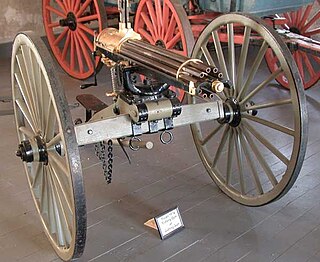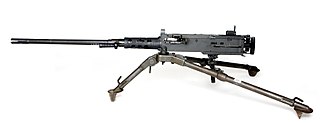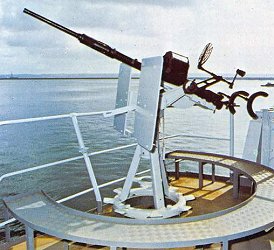
The Gatling gun is a rapid-firing multiple-barrel firearm invented in 1861 by Richard Jordan Gatling. It is an early machine gun and a forerunner of the modern electric motor-driven rotary cannon.

A machine gun (MG) is a fully automatic, rifled auto-loading firearm designed for sustained direct fire with rifle cartridges. Other automatic firearms such as automatic shotguns and automatic rifles are typically designed more for firing short bursts rather than continuous firepower and are not considered true machine guns. Submachine guns fire handgun cartridges rather than rifle cartridges, therefore they are not considered machine guns, while automatic firearms of 20 mm (0.79 in) caliber or more are classified as autocannons rather than machine guns.

The M2 machine gun or Browning .50 caliber machine gun is a heavy machine gun that was designed near the end of World War I by John Browning. While similar to Browning's M1919 Browning machine gun, which was chambered for the .30-06 cartridge, the M2 uses Browning's larger and more powerful .50 BMG cartridge. The design has had many designations; the official U.S. military designation for the infantry type is Browning Machine Gun, Cal. .50, M2, HB, Flexible. It has been used against infantry, light armored vehicles, watercraft, light fortifications, and low-flying aircraft.

The pepper-box revolver or simply pepperbox is a multiple-barrel firearm, mostly in the form of a handgun, that has three or more gun barrels in a revolving mechanism. Each barrel holds a single shot, and the shooter can manually rotate the whole barrel assembly to sequentially index each barrel into alignment with the lock or hammer, similar to rotation of a revolver's cylinder.
A repeating rifle is a single-barreled rifle capable of repeated discharges between each ammunition reload. This is typically achieved by having multiple cartridges stored in a magazine and then fed individually into the chamber by a reciprocating bolt, via either a manual or automatic action mechanism, while the act of chambering the round typically also recocks the hammer/striker for the following shot. In common usage, the term "repeating rifle" most often refers specifically to manual repeating rifles, as opposed to self-loading rifles, which use the recoil, gas, or blowback of the previous shot to cycle the action and load the next round, even though all self-loading firearms are technically a subcategory of repeating firearms.

A chain gun is a type of autocannon or machine gun that uses an external source of power to cycle the weapon's action via a continuous loop of chain similar to that used on a motorcycle or bicycle, instead of diverting excess energy from the cartridges' propellant as in a typical automatic firearm.

A revolver cannon is a type of autocannon, commonly used as an aircraft gun. It uses a cylinder with multiple chambers, similar to those of a revolver handgun, to speed up the loading-firing-ejection cycle. Some examples are also power-driven, to further speed the loading process. Unlike a rotary cannon, a revolver cannon only has a single barrel, so its spun weight is lower. Automatic revolver cannons have been produced by many different manufacturers.
Blowback is a system of operation for self-loading firearms that obtains energy from the motion of the cartridge case as it is pushed to the rear by expanding gas created by the ignition of the propellant charge.

The Oerlikon 20 mm cannon is a series of autocannons based on an original German Becker Type M2 20 mm cannon design that appeared very early in World War I. It was widely produced by Oerlikon Contraves and others, with various models employed by both Allied and Axis forces during World War II. Many versions of the cannon are still used today.

The XM214 Microgun is an American prototype 5.56 mm rotary-barreled machine gun. It was designed and built by General Electric. The XM214 was a scaled-down smaller and lighter version of the M134 Minigun, firing M193 5.56×45mm ammunition.
The ShKAS is a 7.62 mm calibre machine gun widely used by Soviet aircraft in the 1930s and during World War II. The ShKAS had the highest rate of fire of any aircraft machine gun in general service during WWII. It was designed by Boris Shpitalniy and Irinarkh Komaritsky and entered production in 1934. ShKAS was used in the majority of Soviet fighters and bombers and served as the basis for the ShVAK cannon.

The Puckle gun was a primitive crew-served, manually-operated flintlock revolver patented in 1718 by James Puckle (1667–1724), a British inventor, lawyer and writer. It was one of the earliest weapons to be referred to as a "machine gun", being called such in a 1722 shipping manifest, though its operation does not match the modern use of the term. It was never used during any combat operation or war. Production was highly limited and may have been as few as two guns.

The Gast gun was a German twin barrelled machine gun that was developed by Karl Gast of Vorwerk und Companie of Barmen and used during the First World War. Its unique operating system produced a very high rate of fire of 1,600 rounds per minute. The same principle was later used as the basis for the widely used Gryazev-Shipunov GSh-23L series of Russian aircraft autocannon.

The Colt New Model revolving rifles were early repeating rifles produced by the Colt's Manufacturing Company from 1855 until 1864. The design was essentially similar to revolver type pistols, with a rotating cylinder that held five or six rounds in a variety of calibers from .36 to .64 inches. They were mainly based upon the Colt Model 1855 Sidehammer Pocket Revolver developed by Elisha K. Root. Colt revolving pistols and rifles were attractive mainly because of their high rate of fire. They were used to a limited extent on the Pony Express and made a brief appearance in the American Civil War. However, the rifles were generally disliked by soldiers, and were ultimately discontinued due to serious design flaws.

The Billinghurst Requa Battery gun was an early rapid-fire gun used during the American Civil War. It was invented by a Dr. Josephus Requa (1833–1910), a dentist by profession, who had at the age of 16 spent three years as an apprentice to William Billinghurst (1807–1880), a New York riflemaker.
The M1921 Browning machine gun was a water-cooled .50-caliber machine gun, designed by John Moses Browning, which entered production in 1929.

A multiple-barrel firearm is any type of firearm with more than one gun barrel, usually to increase the rate of fire or hit probability and to reduce barrel erosion or overheating.

The Bailey Machine Gun was a rapid-fire weapon developed in the late 19th century. It was a multiple barrel weapon similar to the much more commonly known Gatling gun, and was the first weapon of this type to be belt-fed. Although commonly referred to as the Bailey Machine Gun, it is technically not a machine gun since it is externally powered using a hand crank. However, rapid-fire weapons of this type are commonly referred to as machine guns, even though this usage of the term is technically incorrect.

The Confederate revolving cannon was a weapon developed and used during the U.S. Civil War. The weapon had a design similar to that of a revolver pistol, scaled up to the size of a cannon.

A repeating firearm or repeater is any firearm that is capable of being fired repeatedly before having to be manually reloaded with new ammunition into the firearm.
















